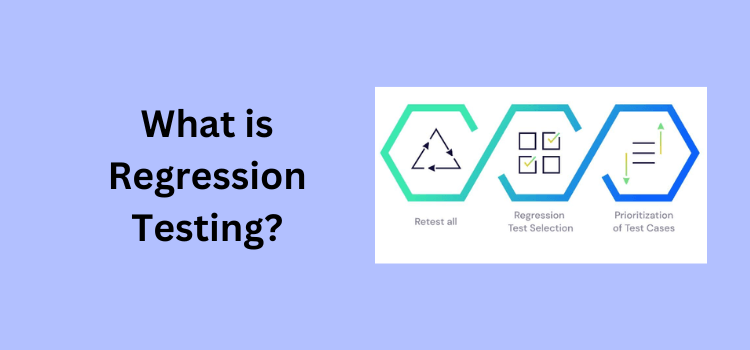Testing is a critical phase of the software development lifecycle. It ensures that the application is free of defects, functions as intended, and meets the specified requirements. Two important types of testing that are often discussed in the context of software development are regression testing and unit testing.
Understanding the difference between regression testing vs unit testing is crucial for implementing an effective testing strategy. While both testing types are essential, they serve different purposes, target different levels of the application, and involve different approaches, tools, and techniques.
A detailed overview of regression testing and unit testing, their advantages and disadvantages, and the tools and techniques used for both is presented. You will gain a thorough understanding of regression testing and unit testing at the end of this article.
What is Unit Testing?

Unit Testing is one of the foundational elements of software testing. It is the first level of software testing where individual components or units of a software application are tested. A unit is the smallest testable part of any software, often a single method, function, or procedure.
The primary goal of unit testing is to validate that each unit of the software performs as designed.
Key Characteristics of Unit Testing
Below are few characteristics you should know —
- Isolation: Each unit or component of the software is tested in isolation from the rest of the code. This means that for testing a single unit, other units or dependencies are replaced by stubs or mocks.
- Automation: Unit tests are usually automated and are integrated into the build process. Automated unit testing helps in achieving quick and consistent results.
- Frequency: Unit tests are run frequently, often after every change in the code, to ensure that new changes do not introduce new defects.
- Granularity: It focuses on testing the smallest part of the software application, usually a single function or method.
Tools and Techniques for Unit Testing
Unit testing is the process of testing individual units or components of a software application to ensure that they function as intended. It is the first level of testing that is performed during the software development process.
Several tools and techniques are available that can help in creating and executing unit tests more effectively.
Popular Tools for Unit Testing
Some of the famous tools for this testing are —
JUnit
JUnit is the most popular testing framework for Java applications. It provides annotations to create and run test cases and test suites. It also provides assertions for validating the results.
NUnit
NUnit is a testing framework for .NET applications. It is similar to JUnit but is specifically designed for .NET applications.
TestNG
TestNG is another testing framework for Java applications. It provides additional functionalities compared to JUnit, like parallel test execution, parameterized tests, and grouping of tests.
MSTest
MSTest is a testing framework provided by Microsoft for .NET applications. It is integrated with Visual Studio and provides a convenient way to create and run unit tests for .NET applications.
Mockito
Mockito is a mocking framework for Java applications. It allows you to create and manage mock objects, which are essential for unit testing code with dependencies.
Techniques for Effective Unit Testing
Go through the methods we’ve given below —
Arrange-Act-Assert (AAA)
This is a pattern for arranging and formatting code in unit tests. It divides the test method into three sections: arrange (set up the test), act (perform the action), and assert (verify the result).
Test-Driven Development (TDD)
This is a software development approach in which tests are written before the code that needs to be tested. The process is primarily divided into the following iterative development cycles: Write a test, write the code, and then refactor the code.
Behavior-Driven Development (BDD)
This is an extension of TDD that focuses on the behavior of the application. It involves writing tests in a natural language style, which improves communication between developers, testers, and non-technical stakeholders.
Mocking
This involves creating mock objects that simulate the behavior of real objects. It is essential for testing code with dependencies.
Advantages & Disadvantages of Unit Testing
Unit testing is a vital part of the software development process. It comes with its own set of advantages and disadvantages. Understanding these will help in deciding the right testing strategy for your application.
Advantages of Unit Testing
The benefits are —
Early Bug Detection
As unit tests are usually written and run by developers as soon as the code is developed, it helps in identifying and fixing bugs at a very early stage.
Facilitates Changes
Having a comprehensive set of unit tests makes it easier to make changes to the code. It ensures that changes or refactoring do not introduce new defects, which is particularly important in non regression testing.
Improves Code Quality
Writing unit tests forces developers to write cleaner, more modular code. This, in turn, improves the overall quality of the code.
Simplifies Debugging
Debugging becomes easier as unit tests focus on a small piece of code. If a test fails, there is a limited amount of code to inspect to find the cause of the issue.
Provides Documentation
Well-written unit tests serve as a form of documentation, making it easier for other developers to understand the functionality of the code.
Disadvantages of Unit Testing
Drawbacks of this testing are —
Time-Consuming
Writing comprehensive unit tests can be time-consuming. This increases the initial development time.
Doesn’t Catch All Bugs
Unit tests focus on individual units of code in isolation. This means that they cannot catch errors that occur due to the interaction between units or in the system as a whole. These types of issues are often caught in regression testing or integration testing.
Can Be Difficult to Write
Writing unit tests for code with many dependencies can be challenging. It may require the use of mocks and stubs to isolate the unit of code, which can be complex to set up.
Maintenance Cost
As the code evolves, the unit tests also need to be updated and maintained. This adds to the ongoing maintenance cost of the project.

What is Regression Testing?
Regression testing is one of the software testing techniques that ensures that previously developed and tested software still functions correctly after recent changes. The primary goal of regression testing is to make sure that new changes to the software do not negatively impact the existing functionality.
Key Characteristics of Regression Testing
So, it’s characteristics are —
Repetitive
Regression testing involves running the same set of test cases multiple times whenever there are changes in the application.
Automated
Due to its repetitive nature, regression testing is often automated. Automated regression testing helps in achieving quick and consistent results and is more cost-effective in the long run.
Comprehensive
It includes running a comprehensive set of test cases that cover all the functionalities of the application.
Tools and Techniques for Regression
Effective regression testing often requires the use of specialized tools and techniques. These tools help in managing and automating the test cases, thereby reducing the time and effort required to execute them.
Automation is particularly important in regression testing due to its repetitive nature.
Popular Tools for Regression Testing
Below are some popular tools —
Selenium
Selenium is one of the most popular tools for automated regression testing. It allows you to write test scripts in various programming languages like Java, C#, and Python. It supports all major browsers and operating systems.
JUnit
JUnit is a widely used testing framework for Java applications. It is commonly used for unit testing but can also be used for regression testing.
TestNG
TestNG is a testing framework inspired by JUnit. It provides additional functionalities like parallel test execution, parameterized tests, and grouping of tests, which are helpful in automated regression testing.
QTP (Quick Test Professional)
QTP is a commercial tool by Micro Focus. It provides a comprehensive environment for regression testing. It allows you to create and execute automated functional and regression tests.
Ranorex
Ranorex is a commercial tool for automated testing of desktop, web, and mobile applications. It provides a user-friendly interface for creating and executing automated regression tests.
Techniques for Effective Regression Testing
The following techniques are often used —
Retest All
This technique involves running all the test cases in the test suite whenever there is a change in the application. This is the most comprehensive approach but is also the most time-consuming.
Regression Test Selection
This technique involves selecting and running only a subset of the test cases from the test suite. The selected test cases are those that are most likely to be affected by the recent changes in the application.
Test Case Prioritization
This technique involves prioritizing the test cases based on certain criteria like the criticality of the functionality, the frequency of use, etc. The higher priority test cases are executed first.
Hybrid Approach
This technique involves combining the above techniques based on the context of the application and the changes made.
Advantages & Disadvantages of Regression Testing
Regression testing is essential to ensure that recent changes in the application do not adversely affect its existing functionality. However, it comes with its own set of advantages and disadvantages.
Advantages of Regression Testing
Some of the benefits are —
Ensures Consistency
It ensures that recent changes, such as bug fixes, new features, or modifications, do not unintentionally affect the existing functionality of the application.
Improves Quality
By catching defects introduced by recent changes, it helps in improving the overall quality of the application.
Reduces Risks
It reduces the risks associated with releasing new versions of the application as it ensures that existing functionalities are not broken.
Facilitates Continuous Improvement
By ensuring that new changes do not adversely affect the application, regression testing facilitates continuous improvement of the application.
Supports Automation
Due to its repetitive nature, regression testing is well-suited for automation. It can help in overcoming some of the challenges associated with regression testing.
Disadvantages of Regression Testing
Some drawbacks are —
Time-Consuming
Running a comprehensive set of test cases multiple times can be very time-consuming, especially for large applications.
Resource Intensive
It requires significant resources, both in terms of time and computing power.
Test Case Maintenance
The test cases used for regression testing need to be continuously updated and maintained to reflect the changes in the application.
Can Be Overlooked
Due to tight schedules and deadlines, there is often a tendency to overlook or skip regression testing, which can lead to defects in the released application.
Comparison Between Regression Testing and Unit Testing
Here is a detailed difference between regression testing and unit testing table.
| Aspect | Regression Testing | Unit Testing |
| Level of Testing | Typically performed at the system or acceptance level of testing. | Performed at the unit or component level of testing. |
| Scope | Involves running a comprehensive set of test cases that cover all the functionalities of the application. | Involves testing individual units or components of the application in isolation. |
| Test Case Creation | Test cases are derived from the requirements and functionalities of the application. | Test cases are derived from the design and implementation of the individual units or components. |
| Test Case Execution | Test cases are often executed manually or automated using specialized tools like Selenium, QTP, or Ranorex. | Test cases are typically automated using unit testing frameworks like JUnit, NUnit, or MSTest. |
| Frequency of Execution | Performed whenever there are changes in the application, such as enhancements, patches, or configuration changes. | Performed continuously throughout the development process. |
| Automation | Due to its repetitive nature, regression testing is often automated. | Unit testing is typically automated as it is performed frequently throughout the development process. |
| Performance | Can be time-consuming and resource-intensive as it involves running a comprehensive set of test cases multiple times. | Is relatively quick and less resource-intensive as it involves testing individual units or components in isolation. |
| Maintenance | Test cases need to be continuously updated and maintained to reflect the changes in the application. | Test cases need to be updated and maintained as the design and implementation of the individual units or components evolve. |
When Do You Need Both Testing Types?
Both unit testing and regression testing are critical aspects of the software testing process, serving different purposes and providing unique benefits. It’s important to understand when and why you need both testing types to ensure the highest quality of your software application.
During Development
Unit testing is essential during the development phase of the software development lifecycle (SDLC). As developers create individual units or components of the application, unit tests should be created and executed concurrently to ensure that each part functions as intended.
This helps in identifying and fixing defects at an early stage of development, which is less costly and time-consuming than fixing them at a later stage.
After Changes or Modifications
When changes are made to an application, such as bug fixes, enhancements, or configuration changes, regression testing is necessary. It ensures that the recent changes do not adversely affect the existing functionality of the application.
Therefore, regression testing is essential whenever there are changes in the application, regardless of whether it is during the development, testing, or maintenance phase of the SDLC.
Continuous Integration and Continuous Deployment (CI/CD)
In a CI/CD environment, where changes are made and deployed frequently, both unit testing and regression testing are essential. Unit testing ensures that the individual units or components function as intended, while regression testing ensures that the changes do not adversely affect the existing functionality of the application.
It’s particularly important in a CI/CD environment as it helps in executing the regression tests quickly and efficiently.
Why Do You Need Both Testing Types?
In software development, ensuring the quality of the application is of utmost importance. A single defect can cause significant problems, impacting the user experience and potentially leading to financial losses.
To mitigate these risks, a comprehensive approach to testing is required, which includes both unit testing and regression testing.
Ensuring Functionality at Every Level
In order to ensure functional integration at all levels, we must implement each method at different times —
Unit Testing
It’s the first level of defense against defects. It involves testing the smallest units of code (e.g., functions, methods, or classes) in isolation from the rest of the application. This helps to ensure that each unit of the application functions as intended and meets the specified requirements.
It helps in identifying and fixing defects at the unit level before they affect other parts of the application or the application as a whole.
Regression Testing
On the other hand, is performed at a higher level. During this process, new changes, such as enhancements, patches, or configurations, are tested to ensure that they do not affect the existing functionality.
This is essential for maintaining the consistency and integrity of the application over time. It helps in identifying and fixing defects that may have been introduced during the development, testing, or maintenance phase of the SDLC.
Supporting Agile Development and Continuous Deployment
Modern software development practices, like Agile and Continuous Deployment, make changes to applications frequently. In such an environment, both unit testing and regression testing are crucial.
Unit Testing
supports Agile development by allowing developers to continuously integrate and refine the individual units or components of the application. This ensures that defects are identified and fixed early in the development process, reducing the risk of defects accumulating over time.
Regression Testing
supports Continuous Deployment by ensuring that the frequent and incremental changes made to the application do not adversely affect its existing functionality. Automated regression testing is particularly important in a Continuous Deployment environment as it helps in executing the regression tests quickly and efficiently.
Wrapping up
Throughout this article, we have discussed in detail the critical aspects of regression testing and unit testing. We have explained the purpose, advantages, and disadvantages of both testing types, discussed the tools and techniques used for both, and highlighted the scenarios when both testing types are needed.
It is clear that both unit testing and regression testing are essential components of a comprehensive testing strategy. While unit testing focuses on testing individual units or components of the application, regression testing ensures that recent changes do not adversely affect the existing functionality of the application.
Understanding the regression testing vs unit testing is crucial for implementing an effective testing strategy and consistency of the application over time. Therefore, it is recommended to implement both testing types appropriately based on the context of the application and the development environment.
Frequently Asked Questions
1. What is the main purpose of unit testing?
Unit testing is performed to ensure that each individual unit or component of the software application functions as intended and meets the specified requirements. It helps in identifying and fixing defects at the unit level before they affect other parts of the application.
2. Can regression testing be automated?
Yes, regression testing can and often should be automated. Automated regression testing helps in executing the tests quickly and efficiently, which is particularly important in Continuous Deployment environments.
3. Is it necessary to perform both unit testing and regression testing?
Yes, it is necessary to perform both unit testing and regression testing as they serve different purposes and target different levels of the application. Testing individual units ensures their functionality, while regression testing ensures that recent changes do not adversely affect existing functionality.
- 5 Best DevOps Platform and Their Detailed Guide For 2024 - December 26, 2025
- Top 10 Cross Browser Testing Tools: The Best Choices for 2024 - October 28, 2025
- 5 Best API Testing Tools: Your Ultimate Guide for 2024 - October 26, 2025
